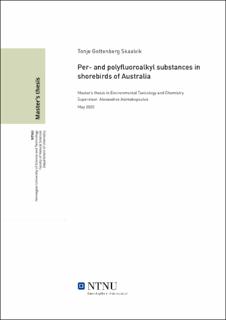| dc.contributor.advisor | Asimakopoulos, Alexandros | |
| dc.contributor.author | Skaalvik, Tonje Gottenberg | |
| dc.date.accessioned | 2021-09-28T18:26:35Z | |
| dc.date.issued | 2020 | |
| dc.identifier | no.ntnu:inspera:53909352:23176110 | |
| dc.identifier.uri | https://hdl.handle.net/11250/2785401 | |
| dc.description.abstract | Australske kystomåder og våtmarker innehar viktige habitater for dyreliv. I disse områdene forbereder trekkfugler seg på sin kommende reise til hekkeområder i nord ved å søke etter mat for å samle opp energi. Kystfugler er spesielt utsatt for miljøgifter da slike stoffer ofte opphopes i kystområder. Forekomsten av miljøgifter, eksempelvis per- og polyfluorerte alkylstoffer (PFASer), i australske kystfugler er ikke blitt grundig undersøkt fra før. I dette studiet undersøkes tre forskjellige trekkfuglers eksponering for PFASer i Australia. Dette gjøres ved å bestemme konsentrasjonen av 15 utvalgte PFASer i prøver av røde blodceller (rbc) fra tundrasnipe (Calidris ferruginea), rødstrupesnipe (Calidris ruficollis) og steinvender (Arenaria interpres), som ble tatt i tidsrommet 2013-2019 på forskjellige steder i Australia. Forskjeller i forekomst av PFASer mellom arter og steder ble undersøkt ved sammenligning av konsentrasjoner, deteksjonsfrekvenser og ved bruk av prinsipal komponent analyse.
De utvalgte PFASene var pefluoroalkyl sulfonater (PFSAer; C4, C6, C8), perfluoroalkyl karboksylsyrer (PFCAer; C5-C14) og perfluoroalkyl sulfonamider (PFOSA, EtPFOSA). Den analytiske metoden besto av Hybrid-SPE for ekstraksjon og væskekromatografi-tandem massespektrometri (LC-MS/MS) for separasjon og deteksjon. Metoden ble evaluert med hensyn på en rekke parametere for kvalitetskontroll, deriblant presisjon, ekstraksjonseffektivitet og matrikseffekter. PFASer ble detektert i de fleste (78%) rbc-prøvene, som viser at disse stoffene også finnes i røde blodceller. Dette er første gang PFASer rapporteres i rbc da tidligere undersøkelser av PFASer er gjort i plasma, serum eller fullblod.
Forekomsten av ulike PFASer samsvarer med de fleste andre studier av fugler ved at PFOS var det mest detekterte stoffet etterfulgt av lange kjeder av PFCAer. Det ble observert store forskjeller i forekomst av PFASer i ulike arter. Disse forskjellene kunne i hovedsak tillegges graden av menneskelig tilstedeværelse på de ulike stedene fuglene oppholdt seg på. PFAS konsentrasjonene i rbc-prøver fra steinvendere som opphold seg på King Island (innbyggertall∼1500) var vesentlig lavere i forhold til konsentrasjonene i tundrasniper og rødstrupesniper som befant seg i kystområder nær Melbourne (innbyggertall∼5 millioner). Tundrasniper og
rødstrupesniper som befant seg i området av et biologisk renseanlegg (Western Treatment Plant) hadde høye og bekymringsverdige konsentrasjoner. Disse konsentrasjonene var i øvre sjiktet av hva som tidligere er blitt rapportert i fugler og var i samme størrelsesorden som konsentrasjoner tilknyttet negative helseeffekter som immuntoksisitet.
Denne avhandlingen gir informasjon vedrørende kystfuglenes eksponering til miljøgifter; informasjon som tidligere ikke har vært kjent. Populasjonsnedgang er observert i de aktuelle fuglene og det er behov for flere slike undersøkelser og økotoksikologiske studier av PFASer og andre miljøgifter for å forstå i hvilken grad forurensning innvirker på populasjonsnedgangen. | |
| dc.description.abstract | Australian coasts and wetlands are important habitats for wildlife, including avian migrants that accumulate energy for their next trans-equatorial flight by foraging in marine sediments at their Australian non-breeding sites. Shorebirds are prone to exposure of environmental contaminants as marine areas are often sinks for
pollution. Exposure of shorebirds to environmental contaminants, such as perand polyfluoroalkyl substances (PFASs), has not been extensively studied in Australia. This study investigates the exposure of three migratory shorebird species to PFASs at their Australian non-breeding grounds. This is done by determining the concentrations of 15 selected PFASs in red blood cells (rbc) of curlew sandpipers (Calidris ferruginea), red-necked stints (Calidris ruficollis) and ruddy turnstones (Arenaria interpres) sampled between 2013 and 2019 at different Australian shorelines. Differences in PFAS occurrence between species and sites were explored through comparison of concentration levels, detection rates and principal component analysis.
Selected PFASs were perfluoroalkyl sulfonates (PFSAs; C4, C6, C8), perfluoroalkyl carboxylic acids (PFCAs; C5-C14) and perfluoroalkyl sulfonamides (PFOSA,EtPFOSA). Extraction and clean up was done applying Hybrid-SPE which allowed for rapid sample preparation of a large number of samples. Liquid chromatography tandem mass spectrometry (LC-MS/MS) was used for separation and detection. The method was successfully evaluated through a number of quality control parameters including precision, recoveries and matrix effects. Detection of PFASs in the majority (78%) of the investigated rbc samples (n=110) demonstrated the presence of these contaminants also in the rbc. This is the first study reporting PFASs in rbc as previous studies have only investigated these contaminants in plasma, serum and whole blood.
Occurrence profiles coincided with most previous avian studies, with PFOS being the most detected and dominant PFAS, followed by long-chained PFCAs. Major differences were observed in PFAS occurrence between species, which were mainly attributed to the degree of human influence on the respective sample sites. PFAS rbc concentrations in ruddy turnstones sampled on shorelines of King Island (∼1500 people) were significantly lower than the concentrations found in curlew sandpipers and red-necked stints sampled in marine areas near the city of Melbourne (∼5 million people). Curlew sandpipers and red-necked stints inhabiting areas of a biological wastewater treatment facility, the Western Treatment Plant, had concerningly high concentrations. The concentrations were in the upper scale of what has previously been reported in avian studies, and similar to concentrations associated with sub-lethal effects such as immunotoxicity. This thesis provides information regarding the exposure of these shorebirds to environmental pollutants. Such information has previously been scarce. The studied shorebirds are experiencing population declines, and further biomonitoring and ecotoxicological studies with regards to PFASs as well as other contaminants of concern should be carried out to understand the role of pollution in these declines. | |
| dc.language | eng | |
| dc.publisher | NTNU | |
| dc.title | Per- and polyfluoroalkyl substances in shorebirds of Australia | |
| dc.type | Master thesis | |
